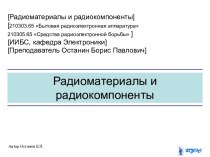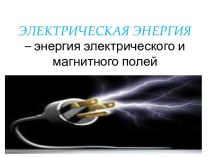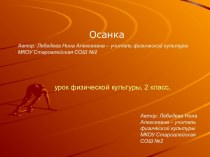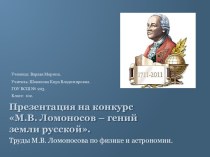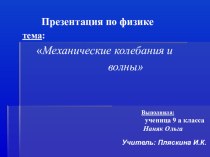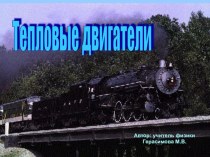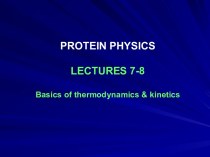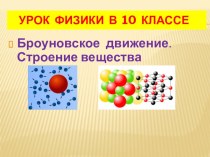- Главная
- Разное
- Бизнес и предпринимательство
- Образование
- Развлечения
- Государство
- Спорт
- Графика
- Культурология
- Еда и кулинария
- Лингвистика
- Религиоведение
- Черчение
- Физкультура
- ИЗО
- Психология
- Социология
- Английский язык
- Астрономия
- Алгебра
- Биология
- География
- Геометрия
- Детские презентации
- Информатика
- История
- Литература
- Маркетинг
- Математика
- Медицина
- Менеджмент
- Музыка
- МХК
- Немецкий язык
- ОБЖ
- Обществознание
- Окружающий мир
- Педагогика
- Русский язык
- Технология
- Физика
- Философия
- Химия
- Шаблоны, картинки для презентаций
- Экология
- Экономика
- Юриспруденция
Что такое findslide.org?
FindSlide.org - это сайт презентаций, докладов, шаблонов в формате PowerPoint.
Обратная связь
Email: Нажмите что бы посмотреть
Презентация на тему Intake and exhaust manifold, design. (Part 1)
Содержание
- 2. OutlinePurpose and background of the projectIntake manifold designExhaust manifold designProto-type designTesting and GoalsConclusion
- 3. PurposeDesign an intake manifold to suite the
- 4. What is an intake manifold?An intake manifold’s
- 6. Parts to the manifoldPlenumThe plenum is the
- 7. RunnersThe runners stem from the plenum and
- 9. Throttle Body or Throttle PlateControls the air
- 10. Fuel Injector LocationTwo main guidelines to followAim
- 11. Ram Air TheoryThis theory is used to
- 13. When the piston drops in a naturally
- 14. Example CalculationEngine B18C1 DOHC 1.8 VTECIntake valve
- 15. David Vizzard’s Rule: Runner LengthBegin with 17.8cm
- 16. Helmholtz ApproximationRPM = = 218,280 x [
- 17. What is a turbo?A turbocharger is used
- 19. Overview of Turbo Manifold DesignGoal of the
- 20. ExamplesShort Tubular – Good Spool, Lacks Top
- 21. Prototype Intake Manifold DesignExplain plenum size of
- 22. TestingThe manifold will be tested on my
- 23. Both setups will be tuned with Neptune
- 24. To read the dyno graph you will
- 25. Example Dyno Graph
- 26. Dyno Video
- 27. The Test Subjecthttp://www.j-k-tuning.com/images/Dragcar.html
- 28. Скачать презентацию
- 29. Похожие презентации
OutlinePurpose and background of the projectIntake manifold designExhaust manifold designProto-type designTesting and GoalsConclusion
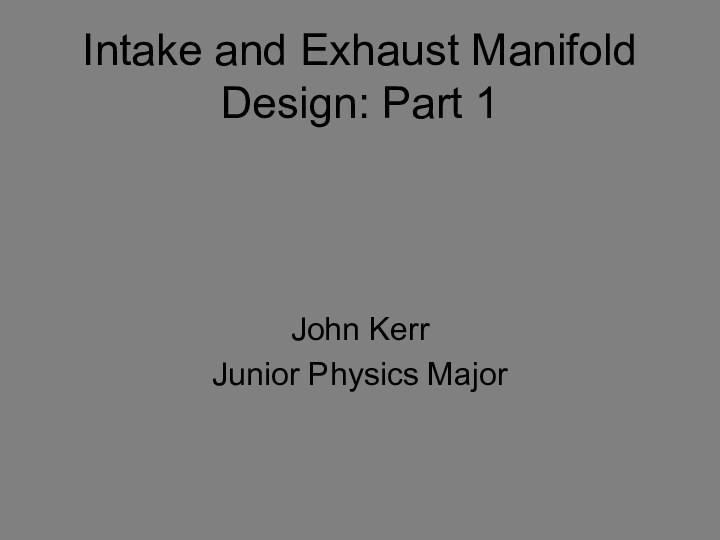


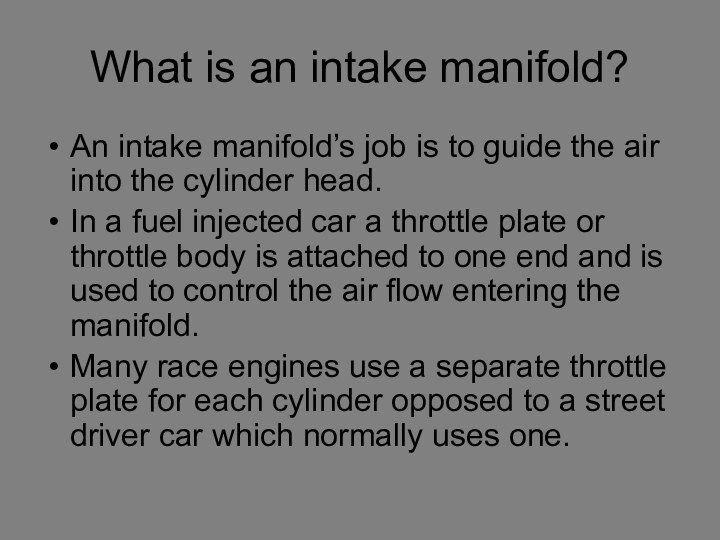
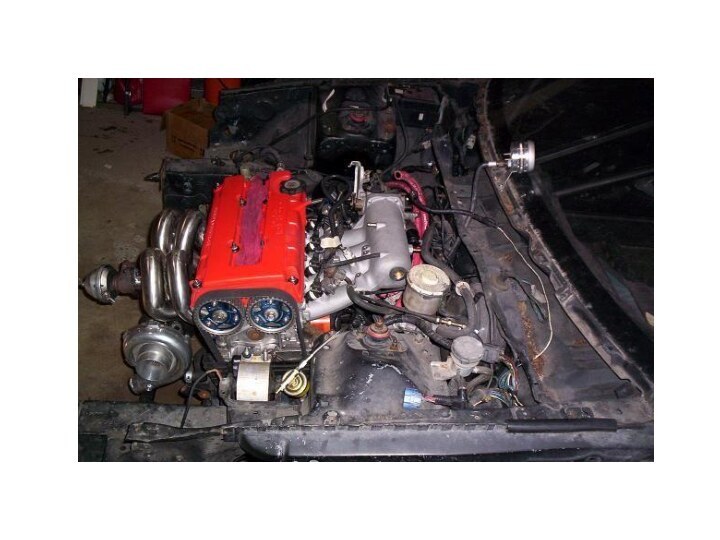
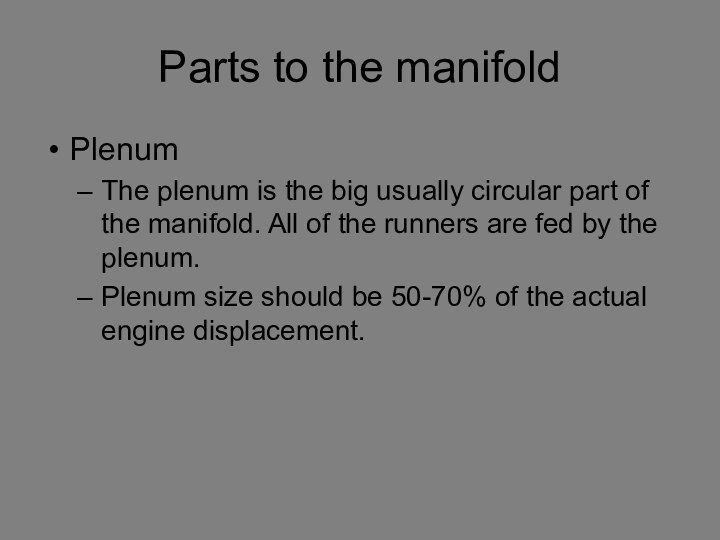
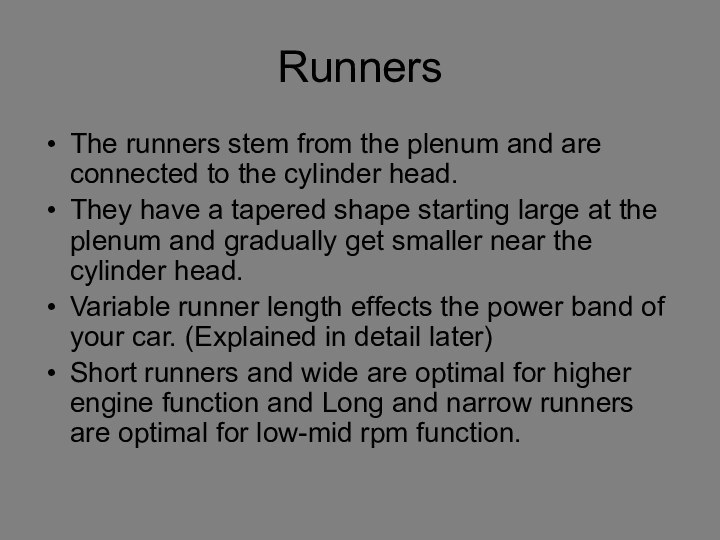
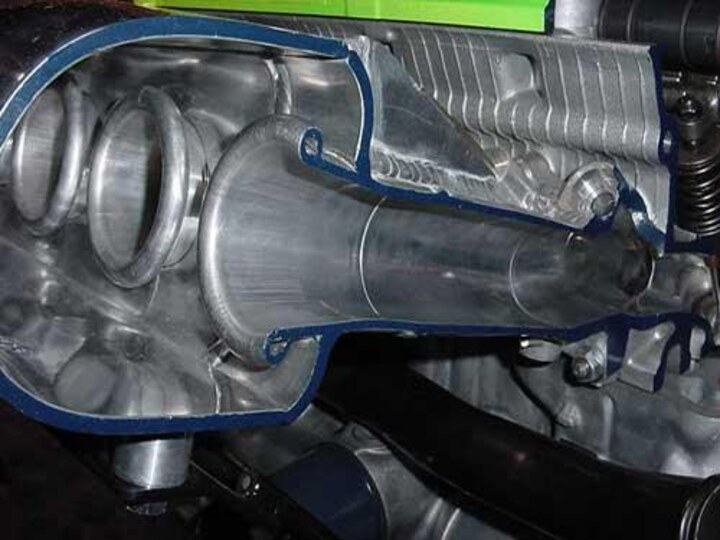
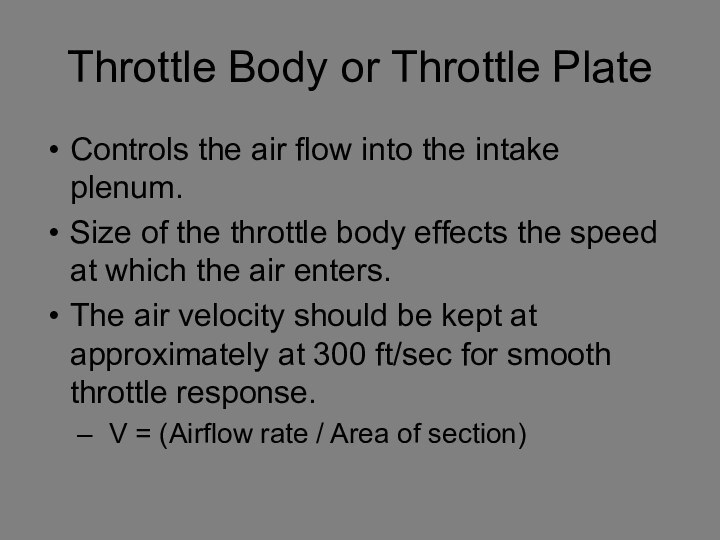

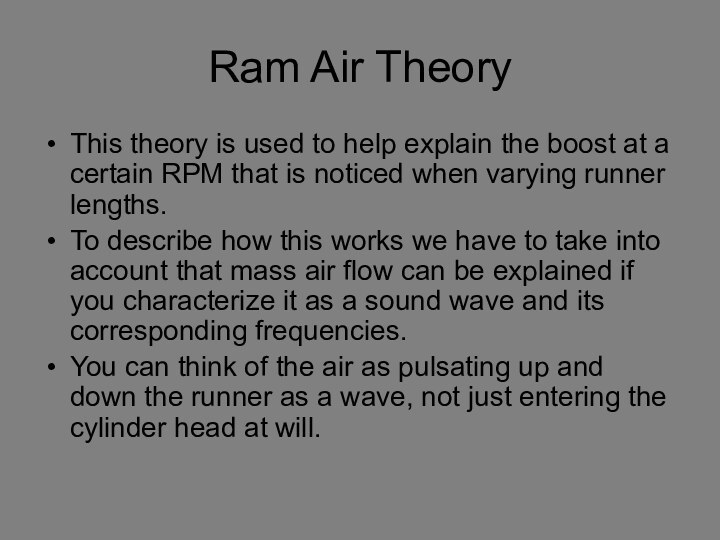

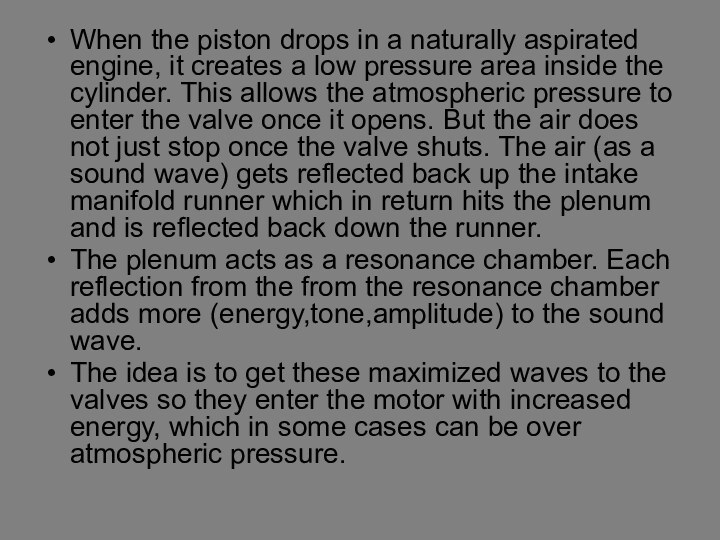
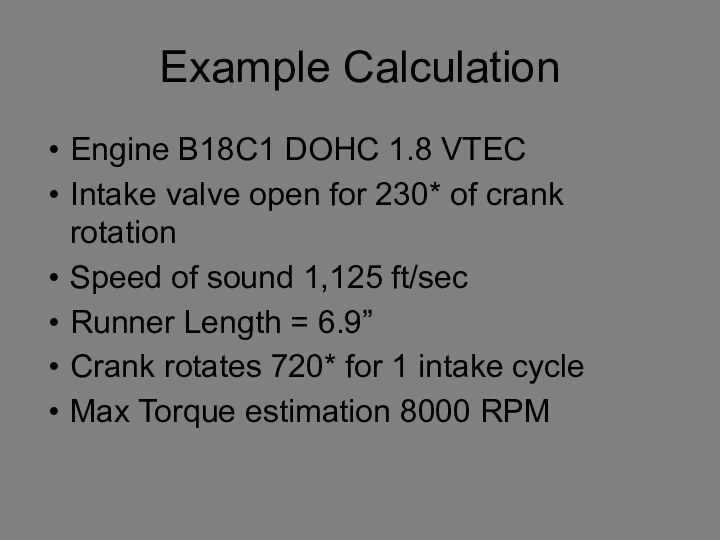

![Intake and exhaust manifold, design. (Part 1) Helmholtz ApproximationRPM = = 218,280 x [ SQRT (S/[L x V] )](/img/tmb/15/1415961/e52a576c0ff5e005d2d37983e2d6961f-720x.jpg)

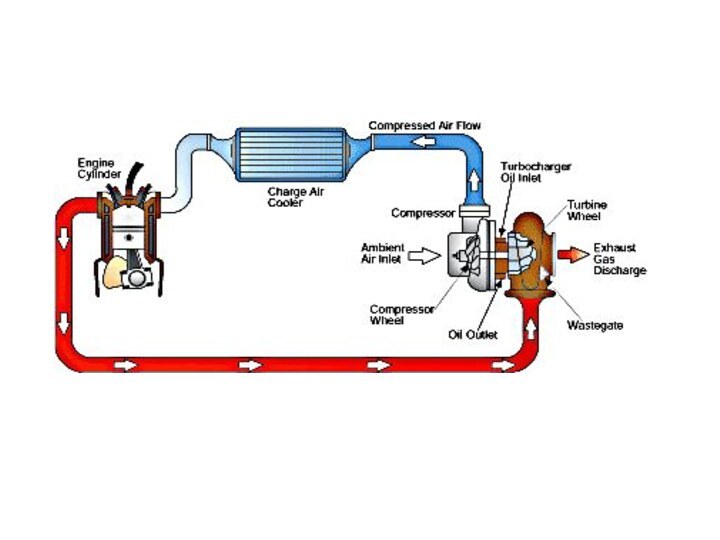

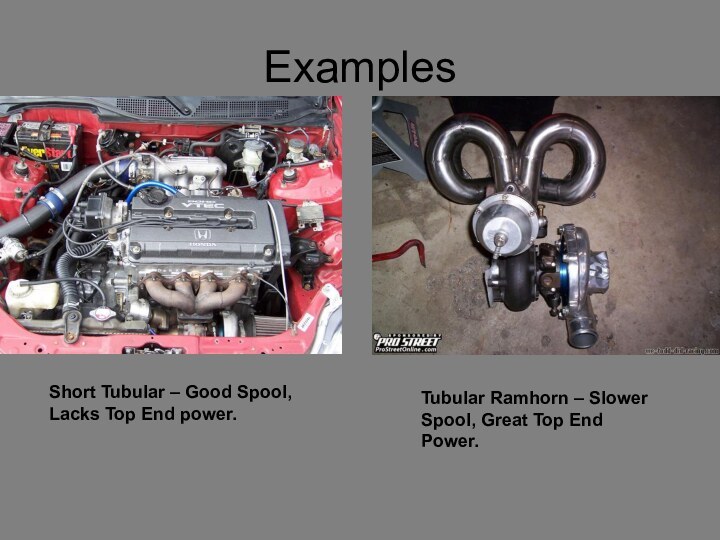
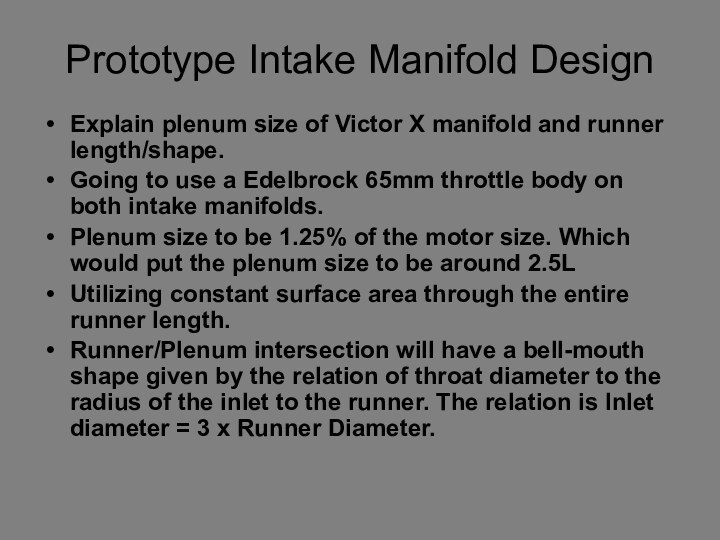



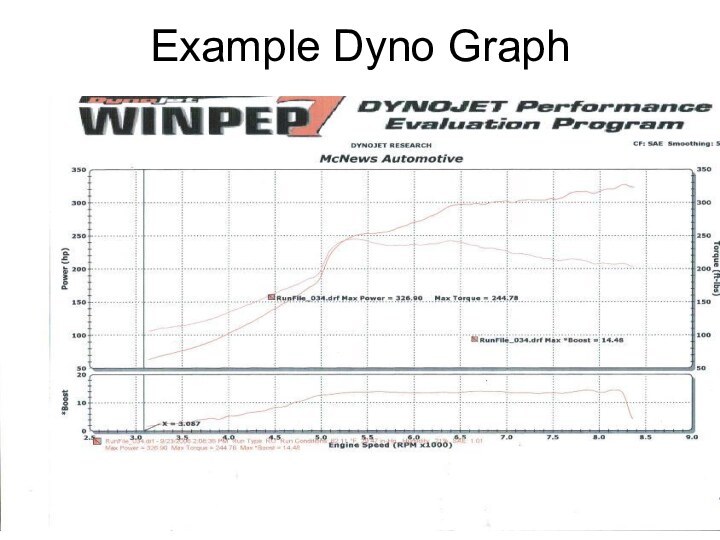
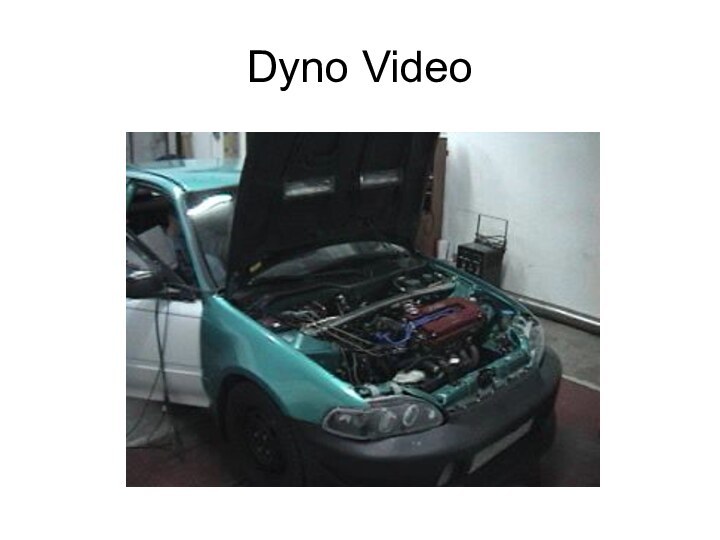

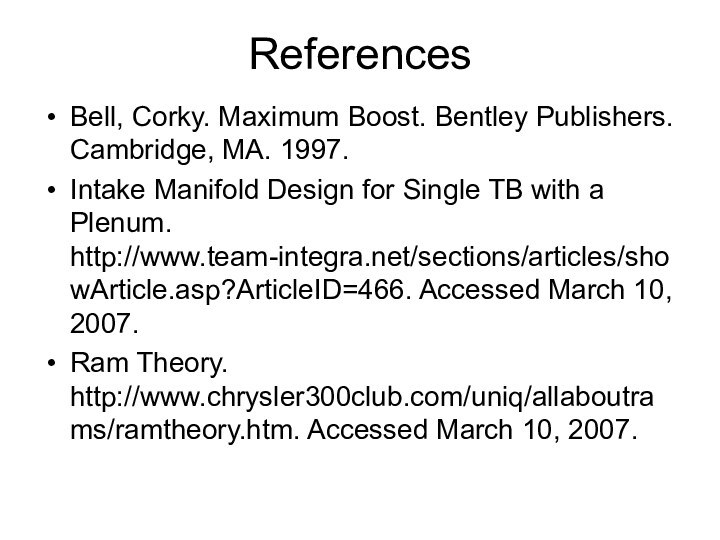
Слайд 3
Purpose
Design an intake manifold to suite the high
rpm function of my race car.
Manifold must produce and
hold power to at least 9500 RPM and also must have a usable power band.The manifold must be pleasing to look at and fit inside the engine bay of the race car.
Слайд 4
What is an intake manifold?
An intake manifold’s job
is to guide the air into the cylinder head.
In
a fuel injected car a throttle plate or throttle body is attached to one end and is used to control the air flow entering the manifold.Many race engines use a separate throttle plate for each cylinder opposed to a street driver car which normally uses one.
Слайд 6
Parts to the manifold
Plenum
The plenum is the big
usually circular part of the manifold. All of the
runners are fed by the plenum.Plenum size should be 50-70% of the actual engine displacement.
Слайд 7
Runners
The runners stem from the plenum and are
connected to the cylinder head.
They have a tapered shape
starting large at the plenum and gradually get smaller near the cylinder head.Variable runner length effects the power band of your car. (Explained in detail later)
Short runners and wide are optimal for higher engine function and Long and narrow runners are optimal for low-mid rpm function.
Слайд 9
Throttle Body or Throttle Plate
Controls the air flow
into the intake plenum.
Size of the throttle body effects
the speed at which the air enters.The air velocity should be kept at approximately at 300 ft/sec for smooth throttle response.
V = (Airflow rate / Area of section)
Слайд 10
Fuel Injector Location
Two main guidelines to follow
Aim directly
down the center of the port, located on each
runner.Discharge at a point where velocity is greatest and at an angle of less than 20* with respect to the runner.
High velocity helps to atomize the fuel with the air. Also decreases the chance of fuel to puddle inside the manifold.
A secondary injector can also be added and it can be placed so it discharged upstream, BUT the airflow must be large. This can also help in atomization.
Слайд 11
Ram Air Theory
This theory is used to help
explain the boost at a certain RPM that is
noticed when varying runner lengths.To describe how this works we have to take into account that mass air flow can be explained if you characterize it as a sound wave and its corresponding frequencies.
You can think of the air as pulsating up and down the runner as a wave, not just entering the cylinder head at will.
Слайд 13 When the piston drops in a naturally aspirated
engine, it creates a low pressure area inside the
cylinder. This allows the atmospheric pressure to enter the valve once it opens. But the air does not just stop once the valve shuts. The air (as a sound wave) gets reflected back up the intake manifold runner which in return hits the plenum and is reflected back down the runner.The plenum acts as a resonance chamber. Each reflection from the from the resonance chamber adds more (energy,tone,amplitude) to the sound wave.
The idea is to get these maximized waves to the valves so they enter the motor with increased energy, which in some cases can be over atmospheric pressure.
Слайд 14
Example Calculation
Engine B18C1 DOHC 1.8 VTEC
Intake valve open
for 230* of crank rotation
Speed of sound 1,125 ft/sec
Runner
Length = 6.9” Crank rotates 720* for 1 intake cycle
Max Torque estimation 8000 RPM
Слайд 15
David Vizzard’s Rule: Runner Length
Begin with 17.8cm and
a max torque of 10,000 RPM.
For every 1000 RPM
you want max torque to be lower, add 4.3cm to the runner length.Example: Max tq at 6000 RPM
L = 17.8 +(4x4.3) = 35 cm or 13.7”
http://www.rbracing-rsr.com/runnertorquecalc.html
Слайд 16
Helmholtz Approximation
RPM = = 218,280 x [ SQRT
(S/[L x V] ) ] x [ SQRT {
(CR-1)/ (CR+1) } ]S= Runner Area
L= Runner Length
CR = Compression Ratio
V= Displacement per cylinder
This approximation uses the resonance chamber, just like the ram air theory.
Слайд 17
What is a turbo?
A turbocharger is used on
race engines to overcome 100% volumetric efficiency. This can’t
be done without some sort of forced induction into the engine. It basically adds more air to the motor.It is driven by exhaust gases from the motor.
Слайд 19
Overview of Turbo Manifold Design
Goal of the manifold
is to direct the exhaust gases through the turbine
side of the turbo.Manifolds are commonly built of 304 stainless steel. It is strong and resists cracking at the high temperatures that the turbo manifold will see.
Manifold should have wastegate priority. The wastegate is what regulates the boost pressure of the compressor side of the turbo.
Volume of runners and runner length should be optimized. For the test vehicle, a long runner manifold such as a top mount or a ramhorn manifold should be used, with fluid bends not sharp angles.
Слайд 20
Examples
Short Tubular – Good Spool, Lacks Top End
power.
Tubular Ramhorn – Slower Spool, Great Top End Power.
Слайд 21
Prototype Intake Manifold Design
Explain plenum size of Victor
X manifold and runner length/shape.
Going to use a Edelbrock
65mm throttle body on both intake manifolds.Plenum size to be 1.25% of the motor size. Which would put the plenum size to be around 2.5L
Utilizing constant surface area through the entire runner length.
Runner/Plenum intersection will have a bell-mouth shape given by the relation of throat diameter to the radius of the inlet to the runner. The relation is Inlet diameter = 3 x Runner Diameter.
Слайд 22
Testing
The manifold will be tested on my race
car. The motor will be a Sleeved 2.0L LS/VTEC
motor, with a built cylinder head and forged bottom end allowing for high rpm power and the ability to withstand high boost pressures.The test will be done against my Victor X manifold at 14, 20 and 25 psi.
The test will be monitored in a fully controlled environment on a chassis dyno.
Слайд 23 Both setups will be tuned with Neptune EMS
by me.
Data logs will be kept of the
various engine sensors, such as manifold pressure, rpm, intake temperature, and air/fuel ratio. These logs will help in the comparison of each manifold.Dyno graphs will be used to compare the torque/horsepower output of each manifold. To note where each produces the most power.
Слайд 24 To read the dyno graph you will notice
horsepower and torque are on the Y-axis and RPM
is on the X-axis.As you can see Horsepower is a function of the engine torque. The equation is
HP = (RPM x TQ)/ (5252)
When HP and Tq are equal, the RPM=5252
The number 5252 is derived by the unit for 1 HP. 1 HP= 33,000 ft-lbs/min. To get 5252 you divide 33,000 by (2xPi).

